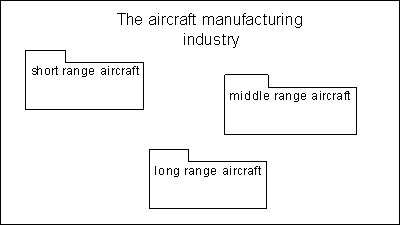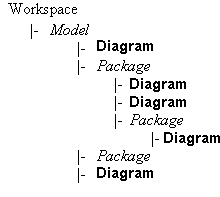A package is a general purpose mechanism for organizing elements into groups. It contains model objects and is available for creation in all diagrams.
When you work with large models, you can split them into smaller subdivisions to avoid manipulating the entire set of data of the model. Packages can be useful to assign portions of a model, representing different tasks and subject areas to different development teams.

Package Hierarchy
You can create several packages at the same hierarchical level within a model or decompose a package into other packages and continue this process without limitation in decomposition depth. Each package is displayed with a default diagram window. At each level of decomposition you can create several diagrams.
However, in an activity or statechart diagram, it is not possible to create a package in a composite activity or composite state since those ones are behaving like a package.
For more information on packages, see "Packages" in the Models chapter of the Core Features Guide.
Composite View
You can expand a package to have a global view of the whole diagram content by right-clicking a package and select . You must resize the composite package symbol to visualize its content:

To return to the package normal view, right-click the symbol and select .
Note that if you double-click the composite view, you automatically open the sub-package diagram.
For more information on the composite view feature, see "Displaying the sub-diagram of a decomposed object within its symbol" in the Diagrams and Symbols chapter of the Core Features Guide.

You can create any type of diagrams in a package, or in a model. You use packages to organize your objects into functional or organizational domains.
If you delete a package, you also delete the diagrams and the objects it contains.
Objects created in a model or a package are shared between the diagrams of same type created in the same model or package.